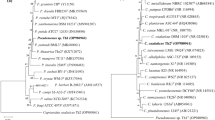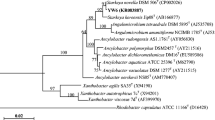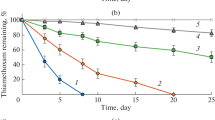Abstract
Pymetrozine is an insecticide that is widely used, causing severe environmental problems. This study determined the pymetrozine degradation by an enrichment culture of microorganisms from paddy soil. The results showed that the enrichment culture utilized 67.3 ± 10.1% of the pure substrate as the sole carbon and nitrogen source in liquid media after 36 h. However, the utilization rates of pymetrozine in herbicide were lower than those of the pure substrate. The maximum utilization rates of pure pymetrozine and pymetrozine in herbicide were 0.051 ± 0.006 and 0.039 ± 0.004 mmol/h, respectively. During the degradation, the metabolites 4-amino-6-methyl-4,5-dihydro-2H-[1,2,4]triazine-3-one and nicotinic acid were produced and then further degraded. In addition, the inoculation of a fungal strain, Phanerochaete sp. Th1, which degraded rice straw components, increased pymetrozine degradation in rice straw and soil. The study provides essential information on pymetrozine degradation in liquid media, rice straw during solid-state fermentation, and soil.





Similar content being viewed by others
REFERENCES
Badawy, M.E., Nasr, H.M., and Rabea, E.I., Toxicity and biochemical changes in the honey bee Apis mellifera exposed to four insecticides under laboratory conditions, Apidologie, 2015, vol. 46, pp. 177–193. https://doi.org/10.1007/s13592-014-0315-0
Butler, D., Scientists hail European ban on bee-harming pesticides, Nature, 2018.
Duc, H.D., Thuy, N.T.D., Thanh, L.U., Tuong, T.D., and Oanh, N.T., Degradation of diuron by a bacterial mixture and shifts in the bacterial community during bioremediation of contaminated soil, Curr. Microbiol., 2021, vol. 79, no. 1, p. 11. https://doi.org/10.1007/s00284-021-02685-5
Duc, H.D., Thuy, N.T.D., Truc, H.T.T., Nhu, N.T.H., and Oanh, N.T., Degradation of butachlor and propanil by Pseudomonas sp. strain But2 and Acinetobacter baumannii strain DT, FEMS Microbiol. Lett., 2020, vol. 367, no. 18, p. fnaa151. https://doi.org/10.1093/femsle/fnaa151
Duc, H.D., Enhancement of carbofuran degradation by immobilized Bacillus sp. strain DT1, Environ. Eng. Res., 2022, vol. 27, no. 4, p. 210158.https://doi.org/10.4491/eer.2021.158
EPA., Pesticides-Fact Sheet for Pymetrozine. https:// www3.epa.gov/pesticides/chem_search/reg_actions/registration/fs_PC-101103_01-Aug-00.pdf (accessed August, 2014), 2000.
Fuog, D., Fergusson, S., and Flückiger, C., Pymetrozine: a novel insecticide affecting aphids and whiteflies, in Insecticides with Novel Modes of Action, 1998, pp. 40–49.
JMPR. (The Joint FAO/WHO Meeting on Pesticide Residues) JMPR Report: Pymetrozine. http://www.fao.org/agriculture/crops/thematic-sitemap/theme/pests/lpe/lpe.
Li, C., Yang, T., Huangfu, W., and Wu, Y., Residues and dynamics of pymetrozine in rice field ecosystem, Chemosphere, 2011, vol. 82, no. 6, pp. 901–904. https://doi.org/10.1016/j.chemosphere.2010.10.053
Pérez-Bárcena, J.F., Ahuatzi-Chacón, D., Castillo-Martínez, K.L., Ruiz-Ordaz, N., Galíndez-Mayer, J., Juárez-Ramírez, C., and Ramos-Monroy, O., Effect of herbicide adjuvants on the biodegradation rate of the methylthiotriazine herbicide prometryn, Biodegradation, 2014, vol. 25, pp. 405–415. https://doi.org/10.1007/s10532-013-9669-7
Ruiz-Hidalgo, K., Chin-Pampillo, J.S., Masís-Mora, M., Carazo, E.R., and Rodriguez-Rodriguez, C.E., Degradation of carbofuran by Trametes versicolor in rice husk as a potential lignocellulosic substrate for biomixtures from mineralization to toxicity reduction, Process Biochem., 2014, vol. 49, pp. 2266–2271. https://doi.org/10.1016/j.procbio.2014.10.006
Shen, G., Hu, X., and Hu, Y., Kinetic study of the degradation of the insecticide pymetrozine in a vegetable-field ecosystem, J. Hazard. Mater., 2009, vol. 164, nos. 2−37, pp. 497–501. https://doi.org/10.1016/j.jhazmat.2008.08.020
Sun, G., Zhang, M., Liu, X., Gao, Q, Jiang, W., Zhou, Y., Wang, H., Cui, M., Qiu, J., Xu, J., and Hong, Q., Isolation and characterization of the pymetrozine-degrading strain Pseudomonas sp. BYT-1, J. Agric. Food Chem., 2019, vol. 67, no. 15, pp. 4170–4176. https://doi.org/10.1021/acs.jafc.8b06155
Talebi, K. and Ghazizadeh, H.A., Determination of pymetrozine residues in cucumber, Commun. Agric. Appl. Biol. Sci., 2006, vol. 71, pp. 75–78.
Van Soest, P.J., Rovertson, J.B., and Lewis, B.A., Methods for dietary fiber, neutral detergent fiber, and nonstarch polysaccharides in relation to animal nutrition, J. Dairy Sci., 1991, vol. 74, pp. 3583–3597. https://doi.org/10.3168/jds.S0022-0302(91)78551-2
Vela, N., Fenoll, J., Garrido, I., Perez-Lucas, G., Flores, P., Hellin, P., and Navarro, S., Reclamation of agro-wastewater polluted with pesticide residues using sunlight activated persulfate for agricultural reuse, Sci. Total Environ., 2019, vol. 660, pp. 923–930. https://doi.org/10.1016/j.scitotenv.2019.01.060
Wyss, P. and Bolsinger, M., Plant-mediated effects on pymetrozine efficacy against Aphids, Pest. Manag. Sci. 2015, vol. 50, pp. 203–210. https://doi.org/10.1002/(SICI)1096-9063(199707)50:3<203::AID-PS584>3.0.CO;2-W
Xu, W.M., Zhang, M., Wei, K., Chen,Y., Liu, Q., Xue, W., Jin, L.-H., He, M., Chen, Z., and Zeng, S., Development and evaluation of pymetrozine controlled-release formulation to control paddy planthopper, RSC Adv., 2018, vol. 8, no. 40, pp. 22687–22693. https://doi.org/10.1039/c8ra03516d
Yildirim, Z., Kayraldiz, A., Donbak, L., et al., Analysis of genotoxicity of pymetrozine in human peripheral lymphocytes, Case Study and Case Report., 2017, vol. 7, pp. 30–42. https://doi.org/10.1515/aiht-2015-66-2584
Yu, J., Xu, E.G., Li, W., Jin, S., Yuan, T., Liu, J., Li, Z., and Zhang, T., Acute toxicity of an emerging insecticide pymetrozine to Procambarus clarkii associated with rice-crayfish culture (RCIS), Int. J. Environ. Res. Public Health. 2018, vol. 15, p. 984. https://doi.org/10.3390/ijerph15050984
Zhang, Y., Zhang, L., Xu, P., Li, J., and Wang, H., Dissipation and residue of pymetrozine in rice field ecosystem, Environ. Monit. Assess., 2015, vol. 187, no. 3, p. 78. https://doi.org/10.1007/s10661-014-4256-x
ACKNOWLEDGMENTS
The authors are grateful to the anonymous reviewers and editors, whose suggestions helped to improve this manuscript.
Funding
This work was supported by ongoing institutional funding. No additional grants to carry out or direct this particular research were obtained.
Author information
Authors and Affiliations
Corresponding author
Ethics declarations
ETHICS APPROVAL AND CONSENT TO PARTICIPATE
This work does not contain any studies involving human and animal subjects.
CONFLICT OF INTEREST
The authors of this work declare that they have no conflicts of interest.
Additional information
Publisher’s Note.
Pleiades Publishing remains neutral with regard to jurisdictional claims in published maps and institutional affiliations.
Rights and permissions
About this article
Cite this article
Duc, H.D., Oanh, N.T. Pymetrozine Degradation by an Enrichment Culture from Paddy Soil. Microbiology 93, 324–332 (2024). https://doi.org/10.1134/S002626172360249X
Received:
Revised:
Accepted:
Published:
Issue Date:
DOI: https://doi.org/10.1134/S002626172360249X




